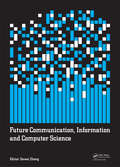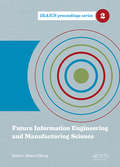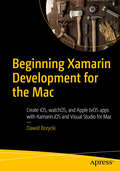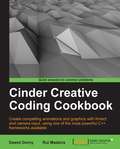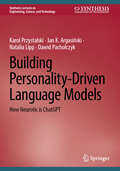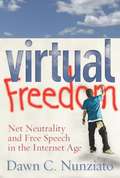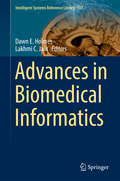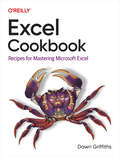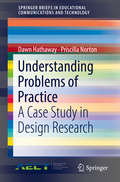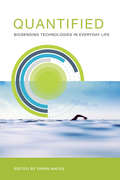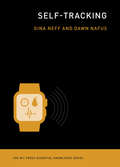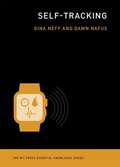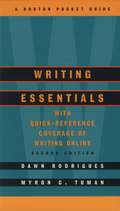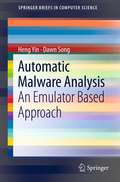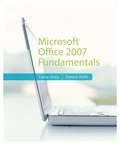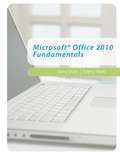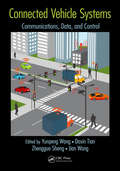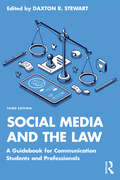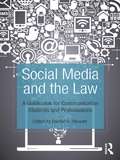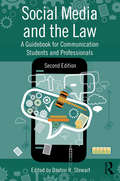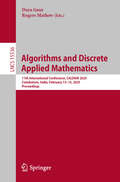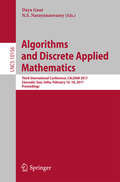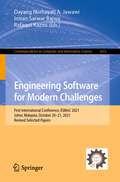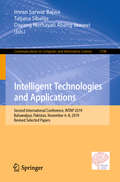- Table View
- List View
Future Communication, Information and Computer Science: Proceedings of the 2014 International Conference on Future Communication, Information and Computer Science (FCICS 2014), May 22-23, 2014, Beijing, China.
by Dawei ZhengThe 2014 International Conference on Future Communication, Information and Computer Science (FCICS 2014) was held May 22-23, 2014 in Beijing, China. The objective of FCICS 2014 was to provide a platform for researchers, engineers and academics as well as industrial professionals from all over the world to present their research results and development activities in Computer, Network and Information Technology and Communication Engineering.
Future Information Engineering and Manufacturing Science: Proceedings of the 2014 International Conference on Future Information Engineering and Manufacturing Science (FIEMS 2014), June 26-27, 2014, Beijing, China (IRAICS Proceedings)
by Dawei ZhengThe 2014 International Conference on Future Information Engineering and Manufacturing Science (FIEMS 2014) was held June 26-27 in Beijing, China. The objective of FIEMS 2014 was to provide a platform for researchers, engineers, academics as well as industry professionals from all over the world to present their research results and development acti
Beginning Xamarin Development for the Mac: Create iOS, watchOS, and Apple tvOS apps with Xamarin.iOS and Visual Studio for Mac
by Dawid BoryckiDevelop apps for the iPhone, iPad, and Apple wearables using Visual Studio for the Mac. Learn how to set up your development environment and emulators, and how to create adaptive user interfaces for various platforms. Expert Dawid Borycki guides you through the fundamentals of programming for Apple platforms (Model View Controller, Test Driven Development), navigation patterns, gesture handling, accessing user's location, and reading and consuming data from web services. After reading this book, you will be able to build native apps that look and feel like other apps built into iOS, watchOS, and tvOS, and have the skills that are in high demand in today's market. If you are already programming C# apps for web or desktop, you will learn how to extend your skill set to Apple mobile, wearable, and smart TV platforms. What You'll Learn Build and implement native apps for Apple platforms Create adaptive, universal views and handle navigation between them Access user's location and handle touch input Consume data from web services Minimize app development time with C# Who This Book Is For Developers who are interested in mobile and device development, as well as experienced non-Apple developers who want to switch or extend their skill set to programming for Apple platforms
Cinder Creative Coding Cookbook
by Rui Madeira Dawid GornyFull of easy-to-follow recipes and images that will teach powerful techniques and algorithms, building from basic projects to challenging applications. This book is for artists, designers, and programmers who have previous knowledge of C++, but not necessarily of Cinder.
Building Personality-Driven Language Models: How Neurotic is ChatGPT (Synthesis Lectures on Engineering, Science, and Technology)
by Karol Przystalski Jan K. Argasiński Natalia Lipp Dawid PacholczykThis book provides an innovative exploration into the realm of artificial intelligence (AI) by developing personalities for large language models (LLMs) using psychological principles. Aimed at making AI interactions feel more human-like, the book guides you through the process of applying psychological assessments to AIs, enabling them to exhibit traits such as extraversion, openness, and emotional stability. Perfect for developers, researchers, and entrepreneurs, this work merges psychology, philosophy, business, and cutting-edge computing to enhance how AIs understand and engage with humans across various industries like gaming and healthcare. The book not only unpacks the theoretical aspects of these advancements but also equips you with practical coding exercises and Python code examples, helping you create AI systems that are both innovative and relatable. Whether you’re looking to deepen your understanding of AI personalities or integrate them into commercial applications, this book offers the tools and insights needed to pioneer this exciting frontier.
Virtual Freedom
by Dawn C. NunziatoCommunications giants like Google, Comcast, and AT&T enjoy increasingly unchecked control over speech. As providers of broadband access and Internet search engines, they can control online expression. Their online content restrictions-from obstructing e-mail to censoring cablecasts-are considered legal because of recent changes in free speech law. In this book, Dawn Nunziato criticizes recent changes in free speech law in which only the government need refrain from censoring speech, while companies are permitted to self-regulate. By enabling Internet providers to exercise control over content, the Supreme Court and the FCC have failed to protect the public's right to access a broad diversity of content. Nunziato argues that regulation is necessary to ensure the free flow of information and to render the First Amendment meaningful in the twenty-first century. This book offers an urgent call to action, recommending immediate steps to preserve our free speech rights online.
Advances in Biomedical Informatics (Intelligent Systems Reference Library #137)
by Lakhmi C. Jain Dawn E. HolmesThis book presents authoritative recent research on Biomedical Informatics, bringing together contributions from some of the most respected researchers in this field. Biomedical Informatics represents a growing area of interest and innovation in the management of health-related data, and is essential to the development of focused computational models. Outlining the direction of current research, the book will be of considerable interest to theoreticians and application scientists alike. Further, as all chapters are self-contained, it also provides a valuable sourcebook for graduate students.
Excel Cookbook: Recipes for Mastering Microsoft Excel
by Dawn GriffithsFilled with tips, tricks, and techniques, this easy-to-use book is the perfect resource for intermediate to advanced users of Excel. You'll find complete recipes for more than a dozen topics covering formulas, PivotTables, charts, Power Query, and more. Each recipe poses a particular problem and outlines a solution that you can put to use right away—without having to comb through tutorial pages. Whether you're a data analyst, project manager, or financial analyst, author Dawn Griffiths directs you straight to the answers you need. Ideal as a quick reference, Excel Cookbook is also perfect for learning how to work in a more efficient way, leading to greater productivity on the job. With this book, you'll jump in and get answers to your questions—fast. This cookbook shows you how to: Build compelling charts and use Sparklines, 3D Maps, and other visualizations Use PivotTables to slice, dice, and summarize datasets Perform statistical and financial analyses using formulas, Forecast Sheets, the Analysis ToolPak, and more Master dynamic array functions such as SEQUENCE, TEXTSPLIT, and FILTER Use Power Query to import, shape, and combine datasets Create custom functions using LAMBDA formulas Use developer options to write VBA code and create custom UserForms
Understanding Problems of Practice: A Case Study In Design Research (Springerbriefs In Educational Communications And Technology Ser.)
by Dawn Hathaway Priscilla NortonToday, K-12 practitioners are challenged to become educational innovators. Yet, little is available to the practitioner to guide their reflection about the design, development, and implementation of these innovations in their own practice. This brief approaches such problems of practice from the perspectives of design research. Although design research typically centers on the partnership between researchers and practitioners in real-world settings, relationships between researchers and practitioners are not always practical. In this brief, the authors explore how the design research process can make the goals, assumptions, processes, methods, and outcomes of design research uniquely accessible to the practitioner. In clear, explicit language, it introduces design research to practitioners using both expository discussions and a robust narrative case study approach that ably guides the reader through the phases of design research, namely:Theory to innovation to practiceUnderstanding problems of practiceCreating a design solutionAssessing the design solutionEvaluating learning outcomesCapturing lessons for practiceUnderstanding Problems of Practice is a singular resource for teachers and practitioners enrolled in graduate research courses or courses on teacher leadership. It also lends itself well as a supplement to professional development activities and studies at the district, school, and professional learning community levels.
Quantified: Biosensing Technologies in Everyday Life
by Dawn NafusWhat is at stake socially, culturally, politically, and economically when we routinely use technology to gather information about our bodies and environments? Today anyone can purchase technology that can track, quantify, and measure the body and its environment. Wearable or portable sensors detect heart rates, glucose levels, steps taken, water quality, genomes, and microbiomes, and turn them into electronic data. Is this phenomenon empowering, or a new form of social control? Who volunteers to enumerate bodily experiences, and who is forced to do so? Who interprets the resulting data? How does all this affect the relationship between medical practice and self care, between scientific and lay knowledge? Quantified examines these and other issues that arise when biosensing technologies become part of everyday life.The book offers a range of perspectives, with views from the social sciences, cultural studies, journalism, industry, and the nonprofit world. The contributors consider data, personhood, and the urge to self-quantify; legal, commercial, and medical issues, including privacy, the outsourcing of medical advice, and self-tracking as a “paraclinical” practice; and technical concerns, including interoperability, sociotechnical calibration, alternative views of data, and new space for design.ContributorsMarc Böhlen, Geoffrey C. Bowker, Sophie Day, Anna de Paula Hanika, Deborah Estrin, Brittany Fiore-Gartland, Dana Greenfield, Judith Gregory, Mette Kragh-Furbo, Celia Lury, Adrian Mackenzie, Rajiv Mehta, Maggie Mort, Dawn Nafus, Gina Neff, Helen Nissenbaum, Heather Patterson, Celia Roberts, Jamie Sherman, Alex Taylor, Gary Wolf
Self-Tracking: The Mit Press Essential Knowledge Series (The MIT Press Essential Knowledge series)
by Gina Neff Dawn NafusWhat happens when people turn their everyday experience into data: an introduction to the essential ideas and key challenges of self-tracking.People keep track. In the eighteenth century, Benjamin Franklin kept charts of time spent and virtues lived up to. Today, people use technology to self-track: hours slept, steps taken, calories consumed, medications administered. Ninety million wearable sensors were shipped in 2014 to help us gather data about our lives. This book examines how people record, analyze, and reflect on this data, looking at the tools they use and the communities they become part of. Gina Neff and Dawn Nafus describe what happens when people turn their everyday experience—in particular, health and wellness-related experience—into data, and offer an introduction to the essential ideas and key challenges of using these technologies. They consider self-tracking as a social and cultural phenomenon, describing not only the use of data as a kind of mirror of the self but also how this enables people to connect to, and learn from, others.Neff and Nafus consider what's at stake: who wants our data and why; the practices of serious self-tracking enthusiasts; the design of commercial self-tracking technology; and how self-tracking can fill gaps in the healthcare system. Today, no one can lead an entirely untracked life. Neff and Nafus show us how to use data in a way that empowers and educates.
The Self-Tracking
by Gina Neff Dawn NafusPeople keep track. In the eighteenth century, Benjamin Franklin kept charts of time spent and virtues lived up to. Today, people use technology to self-track: hours slept, steps taken, calories consumed, medications administered. Ninety million wearable sensors were shipped in 2014 to help us gather data about our lives. This book examines how people record, analyze, and reflect on this data, looking at the tools they use and the communities they become part of. Gina Neff and Dawn Nafus describe what happens when people turn their everyday experience -- in particular, health and wellness-related experience -- into data, and offer an introduction to the essential ideas and key challenges of using these technologies. They consider self-tracking as a social and cultural phenomenon, describing not only the use of data as a kind of mirror of the self but also how this enables people to connect to, and learn from, others.Neff and Nafus consider what's at stake: who wants our data and why; the practices of serious self-tracking enthusiasts; the design of commercial self-tracking technology; and how self-tracking can fill gaps in the healthcare system. Today, no one can lead an entirely untracked life. Neff and Nafus show us how to use data in a way that empowers and educates.
Writing Essentials: A Norton Pocket Guide
by Dawn Rodriguez Myron C. TumanWriting Essentials combines the essentials of grammar, punctuation, mechanics, and documentation with practical suggestions for writing online.<P> From online prewriting, drafting, group workshopping, revising, and editing, to database searching, navigating the Internet, documenting online sources, and designing documents, Writing Essentials offers practical, hands-on advice for using computers throughout the writing process.
Automatic Malware Analysis: An Emulator Based Approach (SpringerBriefs in Computer Science)
by Heng Yin Dawn SongMalicious software (i.e., malware) has become a severe threat to interconnected computer systems for decades and has caused billions of dollars damages each year. A large volume of new malware samples are discovered daily. Even worse, malware is rapidly evolving becoming more sophisticated and evasive to strike against current malware analysis and defense systems. Automatic Malware Analysis presents a virtualized malware analysis framework that addresses common challenges in malware analysis. In regards to this new analysis framework, a series of analysis techniques for automatic malware analysis is developed. These techniques capture intrinsic characteristics of malware, and are well suited for dealing with new malware samples and attack mechanisms.
Access to Information: Materials, Technologies, and Services for Print Impaired readers
by Tom Mcnulty Dawn SuvinoThis is a book about alternative media for people with print disabilities
Microsoft® Office 2007 Fundamentals
by Dawna Walls Laura StoryTeach your introductory level class the essentials of Microsoft Office 2007 applications with MICROSOFT OFFICE 2007 FUNDAMENTALS. This text is ideal for inexperienced computer users who need to learn Microsoft Office 2007 skills for everyday life. Although introductory in nature, this text is comprehensive enough to cover the most important features of Word, Excel, PowerPoint, Access, and Publisher.
Microsoft® Office 2010, Fundamentals
by Dawna Walls Laura StorySuitable for inexperienced computer users who need to learn Microsoft Office 2010 skills for everyday life, this text is comprehensive enough to cover the important features of Word, Excel, PowerPoint, Access, and Publisher.
Connected Vehicle Systems: Communication, Data, and Control
by Zhengguo Sheng Yunpeng Wang Daxin Tian Wang JianConnected vehicles and intelligent vehicles have been identified as key technologies for increasing road safety and transport efficiency. This book presents and discusss the recent advances in theory and practice in connected vehicle systems. It covers emerging research that aims at dealing with the challenges in designing the essential functional components of connected vehicles. Major topics include intra- and inter-vehicle communications, mobility model of fleet and ramp merging, trace and position data analysis, security and privacy.
Social Media and the Law: A Guidebook for Communication Students and Professionals
by Daxton R. StewartThis fully updated third edition of Social Media and the Law offers an essential guide to navigating the complex legal terrain of social media. Social media platforms like Facebook, Twitter, Instagram, YouTube, and TikTok have become vital tools for professionals in the news and strategic communication fields. As these services have rapidly grown in popularity, their legal ramifications have continued to develop, resulting in students and professional communicators needing to be aware of laws relating to defamation, privacy, intellectual property, and government regulation. Editor Daxton Stewart brings together eleven media law scholars to address key questions, such as the following: To what extent do communicators put themselves at risk for lawsuits when they use these tools? What rights do communicators have when other users talk about them on social networks? How can people and companies manage intellectual property issues consistent with the developing law in this area? This book is essential for students of media, mass communication, strategic communication, journalism, advertising, and public relations, as well as professional communicators that use social media in their role.
Social Media and the Law: A Guidebook for Communication Students and Professionals
by Daxton R. “Chip” StewartSocial media platforms like Facebook, Twitter, Pinterest, YouTube, and Flickr allow users to connect with one another and share information with the click of a mouse or a tap on a touchscreen—and have become vital tools for professionals in the news and strategic communication fields. But as rapidly as these services have grown in popularity, their legal ramifications aren’t widely understood. To what extent do communicators put themselves at risk for defamation and privacy lawsuits when they use these tools, and what rights do communicators have when other users talk about them on social networks? How can an entity maintain control of intellectual property issues—such as posting copyrighted videos and photographs—consistent with the developing law in this area? How and when can journalists and publicists use these tools to do their jobs without endangering their employers or clients? In Social Media and the Law, eleven media law scholars address these questions and more, including current issues like copyright, online impersonation, anonymity, cyberbullying, sexting, and WikiLeaks. Students and professional communicators alike need to be aware of laws relating to defamation, privacy, intellectual property, and government regulation—and this guidebook is here to help them navigate the tricky legal terrain of social media.
Social Media and the Law: A Guidebook for Communication Students and Professionals
by Daxton StewartSocial media platforms like Facebook, Twitter, Instagram, YouTube, and Snapchat allow users to connect with one another and share information with the click of a mouse or a tap on a touchscreen—and have become vital tools for professionals in the news and strategic communication fields. But as rapidly as these services have grown in popularity, their legal ramifications aren’t widely understood. To what extent do communicators put themselves at risk for defamation and privacy lawsuits when they use these tools, and what rights do communicators have when other users talk about them on social networks? How can an entity maintain control of intellectual property issues—such as posting copyrighted videos and photographs—consistent with the developing law in this area? How and when can journalists and publicists use these tools to do their jobs without endangering their employers or clients? Including two new chapters that examine First Amendment issues and ownership of social media accounts and content,?Social Media and the Law brings together thirteen media law scholars to address these questions and more, including current issues like copyright, online impersonation, anonymity, cyberbullying, sexting, and live streaming. Students and professional communicators alike need to be aware of laws relating to defamation, privacy, intellectual property, and government regulation—and this guidebook is here to help them navigate the tricky legal terrain of social media.
Algorithms and Discrete Applied Mathematics: 11th International Conference, CALDAM 2025, Coimbatore, India, February 13–15, 2025, Proceedings (Lecture Notes in Computer Science #15536)
by Daya Gaur Rogers MathewThis book constitutes the refereed proceedings of the 11th International Conference on Algorithms and Discrete Applied Mathematics, CALDAM 2025, held in Coimbatore, India, during February 13–15, 2025. The 30 full papers included in this book were carefully reviewed and selected from 89 submissions.The conference had papers in algorithms and complexity, discrete applied mathematics, computational geometry, graph theory, graph colouring, graph partition, and domination in graphs.
Algorithms and Discrete Applied Mathematics: Third International Conference, CALDAM 2017, Sancoale, Goa, India, February 16-18, 2017, Proceedings (Lecture Notes in Computer Science #10156)
by Daya Gaur N. S. NarayanaswamyThis book constitutes the proceedings of the Third International Conference on Algorithms and Discrete Applied Mathematics, CALDAM 2017, held in Goa, India, in February 2017. The 32 papers presented in this volume were carefully reviewed and selected from 103 submissions. They deal with the following areas: algorithms, graph theory, codes, polyhedral combinatorics, computational geometry, and discrete geometry.
Engineering Software for Modern Challenges: First International Conference, ESMoC 2021, Johor, Malaysia, October 20–21, 2021, Revised Selected Papers (Communications in Computer and Information Science #1615)
by Imran Sarwar Bajwa Dayang Norhayati A. Jawawi Rafaqut KazmiThis volume constitutes selected papers presented at the First International Conference on Engineering Software for Modern Challenges, ESMoC 2021, held in Johor, Malaysia, in October 20-21, 2021.The 17 papers presented were thoroughly reviewed and selected from the 167 submissions. They are organized in the topical sections on software engineering; intelligent systems; software quality.
Intelligent Technologies and Applications: Second International Conference, INTAP 2019, Bahawalpur, Pakistan, November 6–8, 2019, Revised Selected Papers (Communications in Computer and Information Science #1198)
by Imran Sarwar Bajwa Tatjana Sibalija Dayang Norhayati Abang JawawiThis book constitutes the refereed proceedings of the Second International Conference on Intelligent Technologies and Applications, INTAP 2019, held in Bahawalpur, Pakistan, in November 2019.The 60 revised full papers and 6 revised short papers presented were carefully reviewed and selected from 224 submissions. Additionally, the volume presents 1 invited paper. The papers of this volume are organized in topical sections on AI and health; sentiment analysis; intelligent applications; social media analytics; business intelligence;Natural Language Processing; information extraction; machine learning; smart systems; semantic web; decision support systems; image analysis; automated software engineering.
